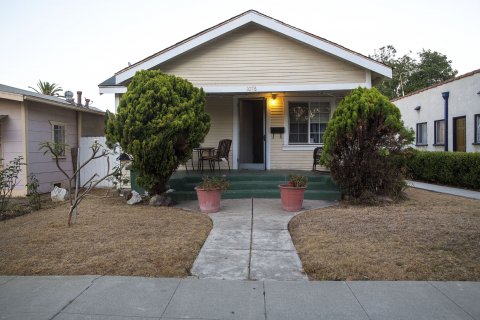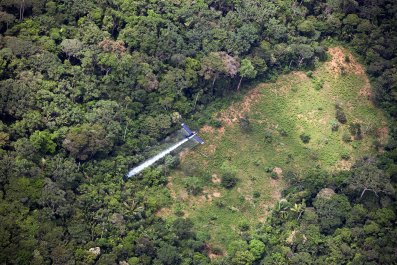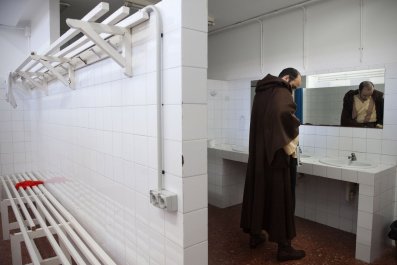Brandon Wilcox had a problem. He was building a dream house for his family in San Diego and wanted the kids to have some grass to play on. But in the midst of the California water crisis, that would be heresy—his neighbors were ripping out their lawns and replacing them with drought-tolerant plants. The environmentally conscientious Wilcox felt ashamed just thinking about it. "I didn't want the stigma," he says, "but I wanted the grass."
After some research, he came across Pearl's Premium, a grass seed cultivated a few years ago by Massachusetts citizen scientist Jackson Madnick. Once it gets established, it needs very little water, Madnick told Wilcox on the phone. What's more, Wilcox would have to mow it only once a month, at most. Some months, he wouldn't need to cut it at all. So Wilcox bought the seeds and began waiting to see if the grass would live up to its promise.
The putting-green yard is an environmentally unsound and relatively recent American fixation, says Ted Steinberg, a professor of history and law at Case Western Reserve University. In his book American Green: The Obsessive Quest for the Perfect Lawn, Steinberg credits the dawn of the lawn to Scotts, the company that has been selling grass seeds since the 19th century. In the 1920s, it began publishing the popular "Lawn Care" newsletter, ramping up the green appeal.
The message to customers was that "you weren't just growing grass, but you're refashioning the outside of your home to mimic the trappings of the aristocratic life," Steinberg says. In the early 20th century, only the rich could afford stretches of lavish green in their yards. But after World War II, potent chemical fertilizers and affordable lawn mowers brought grasses to the masses. Soon the country was seeding, weeding, growing, mowing and watering coast to coast, even though the turf seeds used to sod America weren't meant to flourish in many of its soils.
The most common lawn grasses—like Kentucky blue and bentgrass—were brought here from parts of Europe with plenty of rainfall. Kentucky blue grows very fast and needs a lot of water and mowing—and then it turns brown in winter. Bentgrass has to be cut very low to give golf courses their carpet-like allure. That traumatizes the grass, which requires large amounts of water and fertilizer to rebound.
That watering, however, initiates a cycle of environmental devastation. It leaches nutrients from the soil, which then must be replenished by spreading more fertilizer. Then, as these phosphorus-rich chemicals wash out from the soil, they trickle down into ponds and rivers, causing algae blooms. Toxic pesticides, used to rid lawns of dandelions and clover, wind up in farm fields and the water supply. What's more, people unwittingly carry them into their houses on their shoes, socks and bare feet. "I wouldn't be surprised if they were found in people's refrigerators," Steinberg says. And they're particularly dangerous for pets and children who like to roll on the grass.
By the time lawn chemicals were linked to maladies ranging from asthma to neurological impairments to cancer, lawns were the largest irrigated crop in America, according to 2005 research by Cristina Milesi, a NASA scientist at the time. Based on satellite data and aerial photos, Milesi estimated that, from backyards to golf courses, Americans cultivated almost 50,000 square miles of grass—or three times the amount of irrigated corn. Mowing clippings added up to 37 billion pounds annually, she says—the weight of about 147,000 blue whales. And this is a thirsty crop: A typical suburban lawn sucks down 10,000 gallons of water a year—not even counting the rainfall—according to the Environmental Protection Agency.

And yet there are many benefits to surrounding one's home with patches of lush green. Lawns generate oxygen—a 50-square-foot area makes enough for a family of four, according to the Lawn Institute, a nonprofit that funds grass research on behalf of turfgrass producers. They also trap dirt and dust particles and are carbon dioxide sinks, sequestering carbon from the atmosphere. On hot days, turfgrass lowers surface temperatures, which is the underlying concept behind the trend of planting it on roofs. And of course people like lying, playing and picnicking on the green—and there's nothing wrong with that. It's just that we've been trying to create a perfect lawn with imperfect grass.
That's why Madnick, a multimedia show designer by profession (he plans out those big concerts or theme park shows with lasers, music, fireworks, etc.) and an environmentalist by heart, set off to perfect the grass—a breed that would provide all the environmental and health benefits with none of the detriments. He gathered thousands of seeds from around the world and began growing them in paper coffee cups on his patio, with little water and without fertilizer and pesticides. "Within a year, all [the] grasses perished," he recalls, except for three prickly cactus-like types that no one would want on a lawn. He became convinced that the hardy grass he wanted didn't exist. But that didn't mean it couldn't be created.
Madnick turned to turf scientists. Across the country, university researchers were experimenting with seed mixes; Madnick began to make his own homemade mixes, carefully logging seed types and amounts. But they kept dying too. Finally, five and a half years later, after over 7,000 different tries, a breakthrough: One tiny batch grew very slowly, sprouting thin-blade, emerald-green silky shoots—and didn't die. "I almost couldn't believe it," says Madnick, but he grew more batches of the same mix, with the same result.
The winning combo was a seven-seed mix of perennial rye, Kentucky blue, tall fescue, chewing fescue, sheep fescue and two other fine fescue types. The grasses somehow formed a symbiotic relationship, which enables them to grow very slowly, requiring little fertilizer and mowing, Madnick says. But the real secret was in the grassroots. The typical lawn's roots grow 2 to 3 inches, but Madnick's mix goes 12 to 14 inches downward, tapping deep into the soil water. The exact seed proportions are crucial; otherwise, the roots become shallow again.
He named the grass after his mother, Pearl, and then created two slightly different mixes, one each optimized for shady and sunny conditions. He sold his first bag of seeds in 2009 and then began selling in Whole Food Markets and some Home Depot stores. In 2010, he won the MassChallenge prize in innovation, and in 2013 he was honored by Boston's Museum of Science for his invention. Now Pearl's is growing on more than 300,000 American lawns and will be soon exported to Europe and the Middle East.
Meanwhile, Madnick is still experimenting. "I am testing the upper limits of abuse," he says, chuckling. "How little water or how much salt can the grass tolerate, how much I can terrorize the grass and still keep it alive." So far, Pearl's Premium won't work for soccer or baseball fields because it's too soft and cleats would ruin it, Madnick says, but that's the next frontier.
By now, some of Madnick's customers have had Pearl's Premium for several seasons. Stuart Lund, who lives in the Utah desert at high elevation where rain is a rarity, says that for the past three years he had the greenest lawn in town—to the point that people think it's plastic. A truck driver who is home once every two months, Lund has a sprinkler system that waters his lawn only twice a week, while others do it as often as twice a day.
Massachusetts landscaper Mike Powers has seeded Pearl's Premium on about 100 lawns, including his own, over the past few years. His customers save big on water; over the past year, most traditional lawns had to be watered four times a week to maintain that green, healthy look, Powers says, but after four months without watering it still looks great. Another Massachusetts resident, Karen Weber, says Pearl's Premium was the only grass that ever took on a stubborn hill outside her mother's nursing home. And after the frigid winter of 2014-15, the lawn emerged from under the snow emerald-green.
On Wilcox's lawn, Pearl's Premium has been growing only for three months, but it already has become a local sensation of sorts. "All of my neighbors are talking about it," he says. Wilcox wants to work with the state authorities to get Pearl's Premium on the list of recommended environmentally friendly plants. That would, for all intents and purposes, be the green light needed for other families who want to enjoy their grass without being concerned. "We water it hardly at all now. I rarely mow it, and it looks and feels better than normal grass," Wilcox says. "I call it grass without the guilt."



















